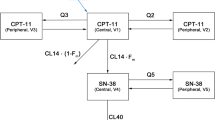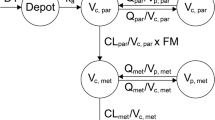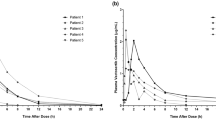Abstract
Tyrosine kinase inhibitors have been marketed as a fixed dose, ‘one size fits all’ treatment strategy. Physicians have also been interested in this method of dosing, knowing the complex planning of other current cancer therapies administered on a mg/m2 or mg/kg basis and subsequent occurrence of dosing error or concern for underdosing. The ‘simple and safe’ strategy of a single dose of tyrosine kinase inhibitor for cancer has thus been widely adopted. However, the benefits purported to exist in the clinical trials do not appear to be borne out in clinical practice, particularly in solid tumours. In order to investigate whether pharmacokinetic variability is a contributor to the variable outcomes, pharmacokinetic targets to enable individualisation of tyrosine kinase inhibitor administration are now emerging. Evidence suggests there is not a clear relationship of a single dose to maximum plasma concentration (C max), steady-state trough concentration (C trough) or area under the curve (AUC). Furthermore, a significant number of questions remain related to the specific timing and frequency of sample collection required to achieve optimal outcomes. This article reviews the wide variability in the literature on this topic, specifically the different pharmacokinetic targets of the same drug for different cancers, for different states of cancer, and changing pharmacokinetic parameters over a treatment interval in cancer. It appears the optimal sampling times to enable appropriate dose recommendations across patients and diseases may vary, and are not always trough concentrations at steady state. Importantly, the need to be pragmatic in a clinical setting is paramount. Lastly, international collaborations to increase sample size are highly recommended to ensure enough patients are sampled to be sure of a clinical benefit from this concentration-directed methodology.

Similar content being viewed by others
References
Pfizer, Inc. SUTENT (sunitinib malate) capsules dosing information [November 2015]. Available at: https://www.pfizerpro.com/product/sutent/advanced-rcc/dosing. Accessed 24 Mar 2016.
Pharmaceutical Benefits Scheme Drug Utilisation Sub-Committee. Novel oral anticoagulants for non-atrial fibrillation indications: utilisation analysis [November 2015]. Available at: http://pbs.gov.au/info/industry/listing/participants/public-release-docs/novel-oral-anticoagulants-10-2014. Accessed 24 Mar 2016.
Awidi A, Ayed AO, Bsoul N, Magablah A, Mefleh R, Dweiri M, et al. Relationship of serum imatinib trough level and response in CML patients: long term follow-up. Leuk Res. 2010;34(12):1573–5.
Ishikawa Y, Kiyoi H, Watanabe K, Miyamura K, Nakano Y, Kitamura K, et al. Trough plasma concentration of imatinib reflects BCR-ABL kinase inhibitory activity and clinical response in chronic-phase chronic myeloid leukemia: a report from the BINGO study. Cancer Sci. 2010;101(10):2186–92.
Larson RA, Druker BJ, Guilhot F, O’Brien SG, Riviere GJ, Krahnke T, et al. Imatinib pharmacokinetics and its correlation with response and safety in chronic-phase chronic myeloid leukemia: a subanalysis of the IRIS study. Blood. 2008;111(8):4022–8.
Picard S, Titier K, Etienne G, Teilhet E, Ducint D, Bernard MA, et al. Trough imatinib plasma levels are associated with both cytogenetic and molecular responses to standard-dose imatinib in chronic myeloid leukemia. Blood. 2007;109(8):3496–9.
Tiseo M, Andreoli R, Gelsomino F, Mozzoni P, Azzoni C, Bartolotti M, et al. Correlation between erlotinib pharmacokinetics, cutaneous toxicity and clinical outcomes in patients with advanced non-small cell lung cancer (NSCLC). Lung Cancer. 2014;83(2):265–71.
Widmer N, Decosterd LA, Csajka C, Montemurro M, Haouala A, Leyvraz S, et al. Imatinib plasma levels: correlation with clinical benefit in GIST patients. Br J Cancer. 2010;102(7):1198–9.
Yu H, Steeghs N, Nijenhuis CM, Schellens JH, Beijnen JH, Huitema AD. Practical guidelines for therapeutic drug monitoring of anticancer tyrosine kinase inhibitors: focus on the pharmacokinetic targets. Clin Pharmacokinet. 2014;53(4):305–25.
Fukudo M, Ito T, Mizuno T, Shinsako K, Hatano E, Uemoto S, et al. Exposure-toxicity relationship of sorafenib in Japanese patients with renal cell carcinoma and hepatocellular carcinoma. Clin Pharmacokinet. 2014;53(2):185–96.
Houk BE, Bello CL, Poland B, Rosen LS, Demetri GD, Motzer RJ. Relationship between exposure to sunitinib and efficacy and tolerability endpoints in patients with cancer: results of a pharmacokinetic/pharmacodynamic meta-analysis. Cancer Chemother Pharmacol. 2010;66(2):357–71.
Motoshima K, Nakamura Y, Sano K, Ikegami Y, Ikeda T, Mizoguchi K, et al. Phase II trial of erlotinib in patients with advanced nonsmallcell lung cancer harboring epidermal growth factor receptor mutations: additive analysis of pharmacokinetics. Cancer Chemother Pharmacol. 2013;72(6):1299–304.
Lankheet NA, Kloth JS, Gadellaa-van Hooijdonk CG, Cirkel GA, Mathijssen RH, Lolkema MP, et al. Pharmacokinetically guided sunitinib dosing: a feasibility study in patients with advanced solid tumours. Br J Cancer. 2014;110(10):2441–9.
Houk BE, Bello CL, Kang D, Amantea M. A population pharmacokinetic meta-analysis of sunitinib malate (SU11248) and its primary metabolite (SU12662) in healthy volunteers and oncology patients. Clin Cancer Res. 2009;15(7):2497–506.
Boudou-Rouquette P, Narjoz C, Golmard JL, Thomas-Schoemann A, Mir O, Taieb F, et al. Early sorafenib-induced toxicity is associated with drug exposure and UGTIA9 genetic polymorphism in patients with solid tumors: a preliminary study. PLoS One. 2012;7(8):e42875.
Boudou-Rouquette P, Ropert S, Mir O, Coriat R, Billemont B, Tod M, et al. Variability of sorafenib toxicity and exposure over time: a pharmacokinetic/pharmacodynamic analysis. Oncologist. 2012;17(9):1204–12.
Narjoz C, Cessot A, Thomas-Schoemann A, Golmard JL, Huillard O, Boudou-Rouquette P, et al. Role of the lean body mass and of pharmacogenetic variants on the pharmacokinetics and pharmacodynamics of sunitinib in cancer patients. Invest New Drugs. 2015;33(1):257–68.
Pecuchet N, Lebbe C, Mir O, Billemont B, Blanchet B, Franck N, et al. Sorafenib in advanced melanoma: a critical role for pharmacokinetics? Br J Cancer. 2012;107(3):455–61.
de Wit D, van Erp NP, den Hartigh J, Wolterbeek R, den Hollander-van Deursen M, Labots M, et al. Therapeutic drug monitoring to individualize the dosing of pazopanib: a pharmacokinetic feasibility study. Ther Drug Monit. 2015;37(3):331–8.
Lankheet NA, Knapen LM, Schellens JH, Beijnen JH, Steeghs N, Huitema AD. Plasma concentrations of tyrosine kinase inhibitors imatinib, erlotinib, and sunitinib in routine clinical outpatient cancer care. Ther Drug Monit. 2014;36(3):326–34.
Wang Y, Chia YL, Nedelman J, Schran H, Mahon FX, Molimard M. A therapeutic drug monitoring algorithm for refining the imatinib trough level obtained at different sampling times. Ther Drug Monit. 2009;31(5):579–84.
Gotta V, Widmer N, Montemurro M, Leyvraz S, Haouala A, Decosterd LA, et al. Therapeutic drug monitoring of imatinib: Bayesian and alternative methods to predict trough levels. Clin Pharmacokinet. 2012;51(3):187–201.
Kramkimel N, Thomas-Schoemann A, Sakji L, Golmard J, Noe G, Regnier-Rosencher E, et al. Vemurafenib pharmacokinetics and its correlation with efficacy and safety in outpatients with advanced BRAF-mutated melanoma. Target Oncol. 2016;11(1):59–69.
Heath EI, Chiorean EG, Sweeney CJ, Hodge JP, Lager JJ, Forman K, et al. A phase I study of the pharmacokinetic and safety profiles of oral pazopanib with a high-fat or low-fat meal in patients with advanced solid tumors. Clin Pharmacol Ther. 2010;88(6):818–23.
Ling J, Fettner S, Lum BL, Riek M, Rakhit A. Effect of food on the pharmacokinetics of erlotinib, an orally active epidermal growth factor receptor tyrosine-kinase inhibitor, in healthy individuals. Anticancer Drugs. 2008;19(2):209–16.
Miura M. Therapeutic drug monitoring of imatinib, nilotinib, and dasatinib for patients with chronic myeloid leukemia. Biol Pharm Bull. 2015;38(5):645–54.
Gotta V, Widmer N, Decosterd LA, Chalandon Y, Heim D, Gregor M, et al. Clinical usefulness of therapeutic concentration monitoring for imatinib dosage individualization: results from a randomized controlled trial. Cancer Chemother Pharmacol. 2014;74(6):1307–19.
Rousselot P, Johnson-Ansah H, Huguet F, Legros L, Escoffre-Barbe M, Gardembas M, et al. Personalized daily doses of imatinib by therapeutic drug monitoring increase the rates of molecular responses in patients with chronic myeloid leukemia. Final results of the randomized OPTIM Imatinib Study. In: American Society of Hematology 57th Annual Meeting and Exposition: Orlando; 5–8 December 2015.
Giles FJ, Yin OQ, Sallas WM, le Coutre PD, Woodman RC, Ottmann OG, et al. Nilotinib population pharmacokinetics and exposure-response analysis in patients with imatinib-resistant or -intolerant chronic myeloid leukemia. Eur J Clin Pharmacol. 2013;69(4):813–23.
Takahashi N, Miura M, Kuroki J, Mitani K, Kitabayashi A, Sasaki O, et al. Multicenter phase II clinical trial of nilotinib for patients with imatinib-resistant or -intolerant chronic myeloid leukemia from the East Japan CML study group evaluation of molecular response and the efficacy and safety of nilotinib. Biomark Res. 2014;2(1):6.
Eechoute K, Fransson MN, Reyners AK, de Jong FA, Sparreboom A, van der Graaf WT, et al. A long-term prospective population pharmacokinetic study on imatinib plasma concentrations in GIST patients. Clin Cancer Res. 2012;18(20):5780–7.
Arrondeau J, Mir O, Boudou-Rouquette P, Coriat R, Ropert S, Dumas G, et al. Sorafenib exposure decreases over time in patients with hepatocellular carcinoma. Invest New Drugs. 2012;30(5):2046–9.
Demetri GD, Wang Y, Wehrle E, Racine A, Nikolova Z, Blanke CD, et al. Imatinib plasma levels are correlated with clinical benefit in patients with unresectable/metastatic gastrointestinal stromal tumors. J Clin Oncol. 2009;27(19):3141–7.
Sharma SK, Kumar S, Vijayakumar AR, Seth T, Mishra P, Mahapatra M, et al. Utility of the trough plasma imatinib level monitoring at two time points in patients with the chronic myeloid leukemia-chronic phase. J Cancer Res Ther. 2014;10(2):305–8.
Goulooze SC, Boddy A, Galettis P, Martin JH. Monte-carlo simulations of the clinical benefits and feasibility of therapeutic drug monitoring of sunitinib in patients with gastrointestinal stromal tumours. 2016 (In submission).
Author information
Authors and Affiliations
Corresponding author
Ethics declarations
Funding
No funding was provided for the preparation of this article. Michael B. Ward is funded by the University of South Australia, Stephanie E. Reuter is funded by the National Health and Medical Research Council (Australia), and Jennifer H. Martin is funded by the University of Newcastle and Calvary Mater Hospital (NSW).
Conflict of interest
Michael B. Ward, Stephanie E. Reuter and Jennifer H. Martin declare no conflicts of interest.
Additional information
M. B. Ward and S. E. Reuter were joint first authors on this work.
Appendix
Appendix
A database search using the terms (Axitinib or Dasatanib or Erlotinib or Imatinib or Nilotinib or Pazopanib or Regorafenib or Sorafenib or Sunitinib or Vemurafenib or Tyrosine Kinase Inhibitor or Protein Kinase Inhibitor) in the title, abstract and keywords, and (Drug Monitoring or Concentration or Target or Trough or Level* or Exposure or Pharmacokinetic*) in the title, abstract and keywords, and (Response or Outcome or Efficacy or Adverse or Tolerability or Toxic* or Individual* or Guid* or Optim* or Sampl*) in the title, abstract and keywords was undertaken using the following databases († indicates run concurrently):
-
CINAHL
-
Cochrane Library
-
EMBASE†
-
International Pharmaceutical Abstracts†
-
Medline†
-
Medline in Process†
The search identified 21,906 papers. A title and abstract search for ‘Timing’ resulted in 440 articles; after removal of duplicates, 419 were screened, of which no original articles described the optimal timing of therapeutic drug monitoring of tyrosine kinase inhibitors.
Rights and permissions
About this article
Cite this article
Ward, M.B., Reuter, S.E. & Martin, J.H. How ‘Optimal’ are Optimal Sampling Times for Tyrosine Kinase Inhibitors in Cancer? Practical Considerations. Clin Pharmacokinet 55, 1171–1177 (2016). https://doi.org/10.1007/s40262-016-0394-3
Published:
Issue Date:
DOI: https://doi.org/10.1007/s40262-016-0394-3




